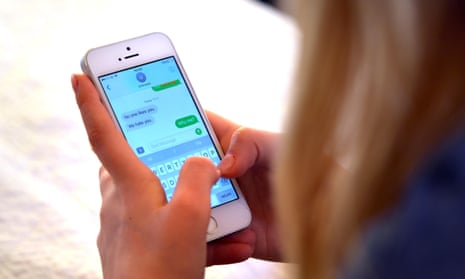Teenage girls are in crisis, and have been for some time. The CDC’s recently released Youth Risk Behavior Survey has received a great deal of media attention, but it’s only one of many alarming studies, even before the pandemic, charting rising rates of depression, suicidal ideation and suicide in girls.
A stream of thinkpieces are asking what lies behind girls’ unhappiness. Some blame social media. Others cite sexual violence: the CDC report found that girls are experiencing an increase – with 14% of them the victims of forced sex, a figure at least three times higher than for boys. Others have speculated that it’s a more generalized misogyny that’s making girls feel hopeless.
But it’s not hard to see how social media and a rise in misogyny are, in fact, related. Social media sites trap girls in spirals questioning their attractiveness and self-worth. They’re encouraged to compare themselves to others and seek approval for the way they look, while reinforcing beauty standards that favor thinness and whiteness. They feel pressured to promote themselves as objects. There have been many studies establishing all this over about the last 10 years, including Facebook’s own research into girls and Instagram – research that the company suppressed until exposed by whistleblower Frances Haugen in 2021.
“Teens blame Instagram for increases in the rate of anxiety and depression,” Facebook’s study noted. “This reaction was unprompted and consistent across all groups.”
From the earliest days of social media, with the 2000 launch of the site “Hot or Not”, where women were rated on the basis of their physical appeal (also the premise of Mark Zuckerberg’s 2003 Facebook precursor, FaceMash), social media has betrayed a sexist bias. Now it has become a promoter of misogynistic content to teenagers. A 2022 investigation by the Guardian revealed that TikTok was pushing celebrity misogynists such as Andrew Tate to male teen users.
The teen boys that teen girls encounter today are affected by this woman-hating online culture, as are girls themselves. As worried as we should be about girls’ struggles with their mental health and wellbeing, we should be concerned about the rise in misogyny among boys – and studying the connection between the two. Online misogynistic radicalization has also been much commented on. Its effects can be seen in the Andrew Tate-like videos boys have been posting, along with those trending videos in which they’ll ask girls misogynistic questions such as how they rate themselves on a scale of one to 10 and what their “body count” (number of sexual partners) is.
When I interviewed girls for my 2016 book American Girls: Social Media and the Secret Lives of Teenagers, almost every one of them had a story about the misogyny she’d encountered online – everything from having posts commented on in a disparaging, sexist way to having nude photos non-consensually shared. Almost every girl I interviewed also had a story about being approached by a predator.
Defenders of social media like to dismiss criticisms of it as a “moral panic”, but online predators remain a serious threat, one that can make the experience of using social media unsettling if not dangerous for girls, and boys as well. This month the Wall Street Journal reported that TikTok has become “every parent’s nightmare: a venue for child sexual exploitation”.
The 2012 death of a 15-year-old Canadian girl, Amanda Todd – who hanged herself after an older man non-consensually shared her nudes online – first made me want to investigate how social media was harming girls. Studies indicate that girls’ struggles have not abated. According to Pew Research, nearly half of teen girls were cyberbullied in 2022, including by “offensive name-calling” and “receiving explicit images they didn’t ask for”. For non-white and LGBTQ+ girls, cyberbullying is even more severe.
TikTok – which most kids say they’re on most of the time – is awash in videos which studies say negatively affect girls’ body image, such as the “bodychecking” trend which promotes repeatedly weighing oneself throughout the day. No wonder girls are depressed.
What should we do? The CDC study said girls are “experiencing a level of trauma and distress that requires immediate action”.
I agree with those who’ve said that both girls and boys should be kept off social media – at least until they turn 16, or until social media companies acknowledge the negative impact they’re having and install reliable age checks, which an increasing number of lawmakers are pushing for.
The cost-benefit analysis is simply not in favor of girls using social media, where it seems as likely they’ll be harmed as enriched. To the parents who say that they need to be in contact with their kids, flip phones work just as well. And to those who say that kids need social media to have friends, in-person friendships have been shown to be more meaningful for people of all ages. Not to mention the saved attention spans and increased number of books that will be read by girls whose parents protect them from the distraction of social media, which is designed to be addictive.
But there’s more that schools and parents should be doing. Schools need to teach more about the history of women and girls – not only for historical accuracy, but as a way to bolster girls’ self-esteem and counteract the effects of online misogyny.
You’d think that by now there would be equal attention paid in history classes to women and men, but sadly that’s far from the case. In 2017, a study by the National Women’s History Museum found that for every three men taught about in America’s schools, only one woman is mentioned – and the majority of these women are white.
Furthermore, 53% of women’s history is taught in the context of women’s domestic roles, with women’s rights and suffrage comprising only 20% of the information.
Students who learn by these standards aren’t able see the impact women have had on US history, according to the report. It is reasonable to extrapolate from this that when boys know little of women’s history, or how women have struggled for equality and basic rights, it’s harder for them to understand their female counterparts and easier to fall prey to misogynistic messaging online. They have virtually no information with which to combat it, especially if they aren’t growing up in households where women are respected. Alarmingly, the same goes for many girls.
Schools can also create spaces for girls and boys to share their experiences of gender stereotypes and harassment. Some high schoolers in a school in Long Island I visited did this, and it was so heartening. A girl talked about feeling a drop in her acceptance of her body after being on social media, then a boy stood up and spoke about the pressure for boys to have “perfect abs”. It increased the girls’ understanding of the boys to know that they, too, felt such anxieties, and the boys were enlightened to learn just how much superficial judgment their female classmates felt on a daily basis.
Education, conversation and increased restrictions on social media use are among what’s needed to help girls at a time when their lives have become consumed with being online, where they are often treated very badly. And there are already signs that the misogynistic bias of technology is only going to continue with the advent of AI. Futurism recently reported that male users of the app Replika, which lets users create chatbots, are creating AI girlfriends and being verbally abusive toward them.
Do we really think the ability to mistreat female chatbots (and soon, female robots) won’t have real world consequences – especially in the behavior of young men and boys who are increasingly isolated and divided from women and girls in real life, because they are spending the majority of their time online?
Nancy Jo Sales is a writer at Vanity Fair and the author of American Girls: Social Media and the Secret Lives of Teenagers

